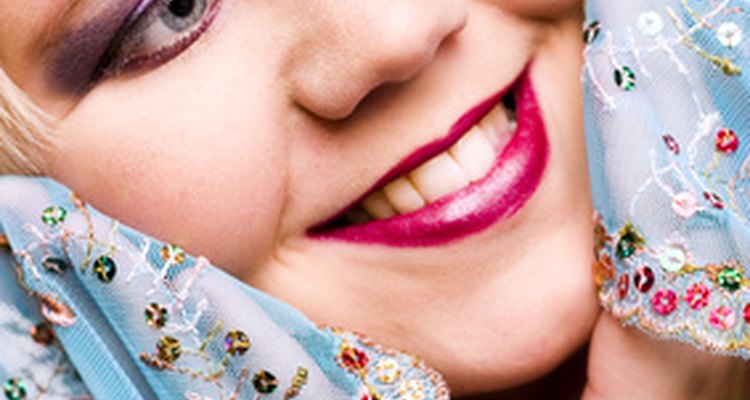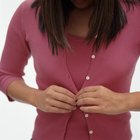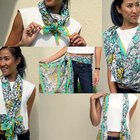
Scarves are one of the most versatile fashion accessories—they can be worn in many ways around the neck, on the head and around the waist or hips. A scarf can add a little something extra to a simple work outfit, spice up jeans and a T-shirt or simply keep the hair out of your face fashionably. Square scarves are very adaptable, and are typically used after folding on the bias line to create a doubled-up triangle.
Fold the square scarf on the diagonal to form a triangle. Place the scarf over your shoulders, with the point of the triangle down your back. Tie the ends of the scarf together at the front, then move the knot over to one side for an asymmetrical look.
Fold the square scarf on the diagonal bias line, forming a triangle. Place the middle of the folded scarf over the forehead, letting the point of the triangle fall down the back of the head. Fold the sides of the scarf back around your head, and tie them in a knot over the point of the triangle for a gypsy look.
Fold the scarf in half lengthwise, then in half again, to form a long, thin rectangular piece. Tie the scarf around your neck, with one end of the scarf longer than the other, hanging down the front of your chest.
Fold the scarf in half lengthwise, then in half again. Place the folded scarf on the hairline, winding it around your head, tying a knot at the nape of your neck, leave one end of the scarf falling over the front of your shoulder.
Fold the scarf in half lengthwise, then in half again to form a long, thin rectangular piece. Thread the scarf through the belt loops of a pair of pants, tying the end together on one hip, letting the ends hang down that hip.
Fold the square scarf on the diagonal to form a triangle. Fold the length of the scarf over a couple of times again, leaving a small tip of triangle free. Place the scarf on your neck, so that the small tip of triangle is in the front. Wrap the scarf around your neck multiple times, tying the ends together at the back.
Related Articles

How to Wear a Short Scarf Around the ...

How to Fold a Dress Shirt to Avoid ...

How to Put on a Bandana on Your Head

How to Make a Pirate Bandana

How to Wash a Pashmina Scarf

How to Tie a Bandana Like Tupac

How to Hang Sweaters So They Don't Get ...

How to Stop Female Facial Hair

How to Tie a Western-Style Bandana

How to Fold a Cardigan

How to Cut Up a Shirt for the Gym

How to Tie a Bandana Skull Cap

How to Tie a Jabot Knot

How to Tie a Kimono Belt for a Man

How to Wear a Bandana Around Your Neck

How to Make a Necktie With Elastic

How to Protect Your Hairdo in the Wind

How to Wrap a Scarf Over the Nose & ...

How to Put Dreads in a Bun

How to Wear a Scarf in Five Different ...
References
Writer Bio
B.T. Alo is media director, chief writer and editor for a U.S.-based marketing and consulting firm. He holds a bachelor's degree in business and communications. Alo's interests include business, investments, electronics, personal finance, health, communication, popular trends and travel.
Photo Credits
smiling scarf image by Frenk_Danielle Kaufmann from Fotolia.com